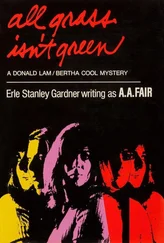I stood for a long time amid the mossy blocks of granite, one of which even displayed fragments of an inscription and a chiseled rune. Lost property — from what century?
Back in the day when Mother and I found refuge in Schwerin, everything was still standing: boulder next to boulder, the Nazi hall of honor, and the massive piece of granite with the martyrs name. When Mother first saw the memorial, it was already neglected, but still under the care of the Party, which was crumbling from the outside in. She told me that she came upon the oaks and beeches, still small at the time, while she was out looking for firewood: “Where they assigned us to, there wasn't a blessed thing to burn in the stove…” Many other women and children were also out looking. By the time the American tanks reached Schwerin from their bridgehead on the Elbe southwest of Boizenburg, followed by the British — ”They had genuine Scotch soldiers…” — we had been moved from the cellar of the school to Lehmstrasse, in the part of town known as the Schelfstadt; it must have been fairly run-down by the end of the war. We were assigned to a brick outbuilding with a tar-paper roof, located, of course, to the rear of the building that fronted on the street. It's still standing, that shack. We had two tiny rooms and a kitchen. You had to go out to the courtyard to use the toilet. They even put in a cylinder stove for us. The stovepipe went through the kitchen window. And to feed the stove — Mother cooked on the cover plate — she had to hunt all over for firewood.
That's how she happened upon the memorial grove. When the British pulled out in June and the Red Army came in, and stayed for good, the boulders with various names and runes chiseled on them remained standing for a long time; the Russians didn't care.
Since the Potsdam conference, where the victors divided up Germany, we were in the Soviet occupation zone, Mother even of her own free will, ever since she discovered, on the largest of the remaining stones, set close to the lakeshore, a name that was not unfamiliar: “That stone had the same name as our Yustloff.. .”
On my last visit to Schwerin, when I stood amid the mossy granite blocks in front of a split boulder and could puzzle out what was left of the name Wilhelm Dahl in cuneiform script — of the first name, only the syllable “helm” was left, next to the split edge — I succumbed to the temptation to picture Mother out hunting for firewood, and coming, with her arms full of branches and twigs, upon the still intact grove and the open memorial hall. On the dozen or so glacial boulders lined up there, she would have deciphered the names of Party members unfamiliar to her but obviously deserving, among them the Kreisleiter of Wismar, Wilhelm Dahl. I see her, small in stature and emaciated, too, standing astonished before the four-meter-high rock, but I can't guess her thoughts, which may have become tangled once she read the inscription on the martyrs stone. But if I know Mother, she certainly didn't hesitate for a moment to step inside the memorial hall in the middle of the grove.
Formed of square granite blocks, it had been built directly on the ground. Into the smooth outside surfaces of the square columns that supported the hall on its open sides, a contemporary sculptor had chiseled SA standard-bearers in outline, larger than life. Affixed to the walls on the interior of the roofless structure were also ten bronze plaques with the names of the dead who were honored there. Eight of the names carried the notation “murdered” after the date of death. The floor of the hall was filthy. Mother told me, “It was full of dog shit…” The granite block for Wilhelm Gustloff, however, stood apart from the row of boulders, at a spot that could be seen from the open memorial hall as particularly significant. From there one had a wide-angle view of the lake. Mother no doubt looked in a different direction. And I was never there when she was out hunting for wood. During her search for anything burnable, a woman from the neighborhood was probably nursing me; her name was Frau Kurbjun. Mother, after all, hardly had a bosom, then or later, just two pointy little pouches.
That's how it goes with monuments. Some of them are put up too soon, and then, when the era of their particular notion of heroism is past, have to be cleared away. Others, like the Lenin statue by the Grosser Dreesch complex, at the corner of Hamburger Allee and Plater Strasse, remain standing. And the monument to the commander of submarine S-13 went up in St. Petersburg barely a decade ago, on 8 May 1990, forty-five years after the end of the war and twenty-seven years after Marinesko's death: a triangular granite column supports the larger-than-life bareheaded bronze bust of the man belatedly designated a “hero of the Soviet Union.”
Former naval officers, by then retired, had established committees in Odessa, Moscow, and elsewhere and persistently petitioned for recognition of the captain, who had died in '63. In Königsberg, as Kaliningrad was called until the end of the war, the bank of the Pregel River behind the Regional Museum was even named after him. That street still bears his name, while the Schlossgartenallee in Schwerin, which from '37 on was called Wilhelm-Gustloff-Allee, still leads to the vicinity of the former memorial grove, but under its old name; similarly, since the fall of the Wall, Lenin-Allee has become Hamburger Allee, and runs through the Grosser Dreesch concrete-slab complex, past the steadfast statue of Lenin. On the other hand, Mothers address, which celebrates the cosmonaut Yuri Gagarin, has remained true to itself.
There is a notable omission. Nothing has been named after the medical student David Frankfurter. No street, no school bears his name. Nowhere was a monument erected to the murderer of Wilhelm Gustloff. No Web site campaigned for a David-and-Goliath sculpture, perhaps in Davos, the scene of the crime. And if my son's bosom enemy had posted such a demand on the Net, the hate pages would certainly have called for the monument to be cleared away by a shaven-headed special operations commando.
That's how it's always been. Nothing lasts forever. Yet the district administration of the NSDAP in Schwerin and the city's mayor went to great trouble after Gustloff s murder to design a memorial grove that would be there for eternity. As early as December 1936, when the trial of Frankfurter was wrapped up in Chur and the verdict reached, the search was under way in the fields of Mecklenburg for glacial boulders to form an enclosure around the memorial grove. The instructions read, “For this purpose natural stones in every size are required, of the sort found near buildings and on native soil around Schwerin…” And a letter written by the Gaus coordinator of ideological training reveals that the regional capital felt obligated to support the Gau administration financially, to the tune of “a subsidy of 10,000 reichsmarks.”
On 10 September 1949, when the dismantling of the grove of honor and the relocation of the corpses and urns was as good as complete, the mayor wrote on his de-Nazified letterhead to the regional government, revealing that this operation had been less costly: “Expenditures of 6,096.75 marks are hereby reported to the regional government for purposes of reimbursement…”
One also discovers that the “residual ashes of Wilhelm Gustloff” could not be transferred to the municipal burial ground: “According to the statement of master mason Kröpelin, G. s urn is located in the foundation of the stone memorial. Removal of the urn is not possible at this time…”
The removal did not take place until the early fifties, shortly before the youth hostel was built and named in memory of the antifascist Kurt Bürger, recently deceased. Around this time, the U-boat hero Marinesko had already spent three years in Siberia. Right after S-/5 sailed into the Finnish harbor of Turku, and the crew went ashore, trouble began for the man who wanted to be celebrated as a hero. Although the NKVD file and the misconduct that had not yet been dealt with in court continued to hang over him, he did not cease, whether cold sober or disinhibited by vodka, to demand recognition for his deeds. Although S-13 was designated a Distinguished Red Banner Boat, and all the crew members received the Order of the War for the Fatherland to pin on their chests, as well another medal, that of the Red Flag, whose motif was the star, hammer, and sickle, Aleksandr Marinesko was not declared a Hero of the Soviet Union. Worse yet, the official bulletins of the Baltic Red Banner Fleet continued to make absolutely no mention of the sinking of the twenty-five-thousand-ton Wilhelm Gustloff, and not a word testified to the rapid sinking of the General von Steuben.
Читать дальше











